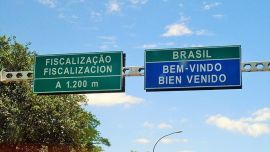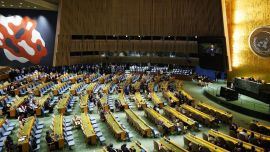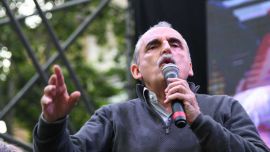Argentina is ablaze, with fires devastating an estimated 7,697 square kms of land so far this year: that’s nearly the size of Puerto Rico, and bigger than the state of Palestine. Put another way, it’s more than half the size of the Malvinas (Falkland) Islands or a quarter of the entire country of Belgium.
Only three provinces, Tierra del Fuego, Santa Cruz and San Juan have escaped any damage, with Córdoba and Entre Ríos bearing the brunt: 4,547 sq km of land has been damaged by fire in these two provinces alone.
The latest figures from Argentina’s Servicio Nacional del Manejo de Fuego (National Fire Management Service, SNMF) are an estimate of the impact of wildfires up to Thursday this week.
Yesterday’s daily SNMF report, released as the Times went to press, also showed 18 wildfires as still “active”: five in Salta, four in Córdoba, three each in Jujuy and Tucumán, two in Catamarca, and one in La Rioja.
A blaze is defined as “active” where firefighters are still battling to contain it, and there is a danger it could spread.
Alberto Seufferheld, the national director of the SNMF, said that conditions on the ground were fuelling the flames.
“We have had severe drought over many years. We have areas which we expect to be flooded where there is virtually no water,” he told the Times.
"The weather systems of El Niño and La Niña affect the cycles of drought and rain, and this year's fires in the Amazon also have an impact.
"Normally an area like the delta of Paraná and other parts of northeast Argentina, where you have subtropical vegetation, you would expect if there is a fire it would quickly go out because of the natural humidity, but all the vegetation is so dry.”
According to the SNMF, 95 percent of fires are caused by man: either deliberately, when preparing land for pasture or plantation, or carelessly, via the tossing a cigarette butt or a failure to extinguish fire embers after a barbecue.
This year, a perfect storm of factors – a harsh winter in many parts of the country, followed by severe drought and high winds – have meant vegetation is dry as tinder, and fires have raged out of control, leading to the devastation seen in dramatic photos from across the nation in the last few weeks.
Fighting the fires
Thousands of firefighters have been battling the blazes, aided by spotter planes and other aircraft loaded with thousands of litres of water to dump on inaccessible regions lashed by flames.
The central province of Córdoba has seen 289,494 hectares (2,895 sq km) burnt since the beginning of August: bigger than the entire surface area of the Polynesian island of Samoa.
This compares to 191,033 hectares burnt during the previous three years, from January 2017 to December 2019.
The national park of Quebrada del Condorito, nesting site of the protected Andean condor, and one of the nation’s smallest at 37,344 hectares recorded roughly 350 hectares damaged by fire in August.
“This has been a critical year. We’re going through the worst drought in 55 years, with only 459mm of rain so far this year,” said Cordoba Province’s Head of Risk Management Claudio Vignetta.
“It has really been impossible to control the fire, we’ve had to concentrate on protecting people’s lives and property,” he added.
Authorities are attempting to tackle the source of the fires too. On Wednesday, a 19-year-old was charged with arson, with potential charges aggravated by the alleged participation of minors. Two boys aged 16 and 17 were also cautioned by police.
They were among five teenagers arrested in Córdoba's Traslasierra region after being spotted by a plane that was assisting firefighters. Last weekend, another youth was arrested in nearby Los Algorrobos Norte, near Route 34.
With fires raging across multiple provinces, the destruction isn’t hard to find. In Argentina’s northeast, the delicate ecosystem of wetlands around the 320-kilometre long Paraná delta has also been left devastated by fire.
One of the largest and most biodiverse regions in the world, the delta spans the provinces of Santa Fe, Entre Rios and Buenos Aires and is home to 700 species, including otters, carpinchos (capybara), coypu rodents, mountain cats, grey foxes and the under-threat marsh deer.
Locals estimate this is the worst damage to the area since 2008, when 70,000 hectares were damaged in fires.
‘Multitude of causes’
In Entre Ríos, outbreaks have been burning since the turn of the year, despite a ban imposed in December 2019 on any type of fire. After Córdoba, it’s the worst-affected province in the country, with 165,208 hectares damaged by fire, compared to just 1,065 hectares over the previous two years.
“The fires in the island reveal the complexity of a problem which is environmental and social, and has a multitude of causes,” said the provincial government’s Environment Secretary Martin Babieri.
“On the one hand, we are confronting a historic low in the level of the river, which has dried up the streams and channels which normally act as a firebreak, and reduced the humidity of the environment, creating ideal conditions for the spread of fire.
“On the other, we face a series of irresponsible practices by people who, for different reasons, put the entire ecosystem at risk.
“The government of Entre Rios is working with the legal authorities to identify the owners of land in the islands, clarifying the chains of responsibility for intentional fires,” he told the Times.
North of the delta is Chaco, the third worst-affected province, with an estimated 85,000 hectares damaged, including 3,000 hectares in Chaco national park and 10,000 hectares in El Impenetrable.
Previous years have seen only minor fires, but nothing significant enough to have been recorded by the national fire authority.
The national park of El Impenetrable receives just a handful of visitors a year, but it protects a diversity of sub-tropical flora and fauna including anteaters, tapirs, peccary pigs and the protected jaguar, as well as a huge range of birds.
A team of park wardens and firefighters finished battling the latest outbreak on Wednesday.
In an interview, Leonardo Juber, the park’s head warden, told the Times that staff were still surveying the impact of the fires.
“We are still inspecting the damage. So far we haven’t found any dead animals, but the larger animals tend to be able to escape. The knock-on effect of this is that it puts pressure on smaller animals in other parts of the national park, so the fires upset the equilibrium.
“Normally, if a fire broke out, there wouldn’t be so much damage, as this is an area which includes wetlands, which would put out the fire. But we’ve had a severe winter, which has dried out the vegetation, high temperatures, lack of rain and high winds, which have had a devastating impact.”
In neighbouring Formosa, most of the fires have been close to the Paraguayan border: and the national park of Rio Pilcomayo has seen 25 percent of its land (13,000 hectares) damaged by fire.
Park chief Nestor Sucunza said that apart from fires spread by neighbouring cattle farmers who were clearing land for pasture, others were started deliberately by illegal hunters to clear land, flush out animals and cover their tracks.
“Groups of three or more come into the park to steal cattle, often armed with guns and knives. The cattle enter through broken fences, damaging the vegetation, along with dogs used to herd them which disturb the local fauna, and in worse cases preying on them.”
Legislative push
Responding to the crisis, the ruling Frente de Todos government has proposed a new bill that would ban the commercial development of any land which has been cleared by fire, whether proven to be deliberate or accidental.
Argentina’s Constitution contains a plethora of other laws which protect the environment (Law 26.815), native woodland (Law 26.331), wetlands (Law 23.919) and international laws on climate change backed by national legislation (Law 24.295 and 27.520).
Activists, however, say they are not followed or used correctly.
“We have laws but people don’t comply with them, they’re not enforced properly, or when they are, the punishment is not adequate,” said campaigner Manuel Jaramillo, director general of the Vida Silvestre Foundation.
“When the state finds itself incapable of tackling the problem, often they introduce a law rather than dedicating resources to solve it.
“All the countryside fires are regulated. In no province are you allowed to burn without authorisation. The laws establish when and where you can burn.
“What we need is greater coordination between provinces and between the provincial and national government, so the fire services aren’t overwhelmed.
“We need more investment and education to help prevent fires.”
Could the latest crisis see the government take a firmer line across the country? Asked directly by the Times whether it was now time to ban all fires nationwide, the national government’s Deputy Environment Minister Sergio Federovisky said that prohibition could only happen “with the cooperation of all the provinces, as they are the ones who manage the resources.”
Globally, 2019 was the second worst year for wildfires since records began, according to the WWF’s Fires, Forests and the Future report.
The catastrophic wildfires in Australia at the turn of the year are estimated to have killed or displaced up to three billion animals. Twenty-six native species were pushed closer to extinction as more than 30 percent of their habitat was burnt, and seven billion plants were destroyed.
Despite a drop in emissions, perhaps the only welcome knock-on effect of restrictions surrounding the Covid-19 pandemic, environmentalists say this year is shaping up to be even worse in terms of fires, with the number in the Brazilian Amazon already hitting a 13-year high.
“If we don’t learn from what’s going on now, 2021 will be even worse. We need the planet more than the planet needs us. If we want to have a healthy human existence free of pandemics and pollution, we need to ensure we have a healthy planet,” said Jaramillo.
| Province | Hectares |
|---|---|
| 1. Córdoba | 289,494 |
| 2. Entre Ríos | 165,208 |
| 3. Chaco | 85,000 |
| 4. Río Negro | 35,572 |
| 5. Santiago del Estero | 29,491 |
| 6. Catamarca | 27,995 |
| 7. Formosa | 20,459 |
| 8. Santa Fe | 20,203 |
| 9. Salta | 15,565 |
| 10. Neuquén | 15,409 |
| 11. San Luis | 14,342 |
| 12. Tucumán | 12,787 |
| 13. Mendoza | 11,250 |
| 14. Chubut | 6,239 |
| 15. Corrientes | 6,656 |
| 16. La Pampa | 5,395 |
| 17. Jujuy | 4,473 |
| 18. La Rioja | 2,240 |
| 19. Misiones | 1,372 |
| 20. Buenos Aires | 584 |
| TOTAL | 769,733 |


























Comments